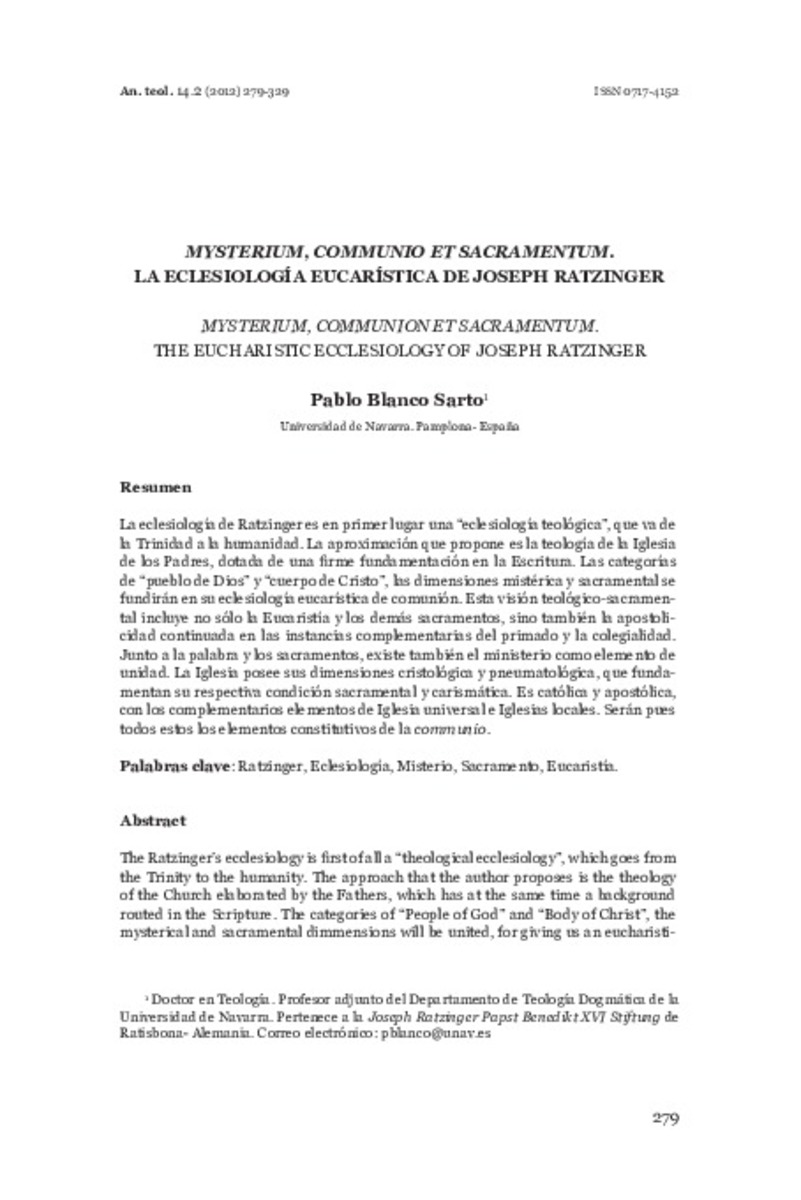Full metadata record
| DC Field | Value | Language |
|---|---|---|
| dc.creator | Blanco-Sarto, P. (Pablo) | - |
| dc.date.accessioned | 2016-11-03T16:48:38Z | - |
| dc.date.available | 2016-11-03T16:48:38Z | - |
| dc.date.issued | 2012 | - |
| dc.identifier.citation | Blanco Sarto, P, Mysterium, communui et sacramentum. La eclesiología eucarística de Joseph Ratzinger, An. Teol. 14.2 (2012), pp. 279-329 | es_ES |
| dc.identifier.issn | 0717-4152 | - |
| dc.identifier.uri | https://hdl.handle.net/10171/42086 | - |
| dc.description.abstract | La eclesiología de Ratzinger es en primer lugar una “eclesiología teológica”, que va de la Trinidad a la humanidad. La aproximación que propone es la teología de la Iglesia de los Padres, dotada de una firme fundamentación en la Escritura. Las categorías de “pueblo de Dios” y “cuerpo de Cristo”, las dimensiones mistérica y sacramental se fundirán en su eclesiología eucarística de comunión. Esta visión teológico-sacramental incluye no sólo la Eucaristía y los demás sacramentos, sino también la apostolicidad continuada en las instancias complementarias del primado y la colegialidad. Junto a la palabra y los sacramentos, existe también el ministerio como elemento de unidad. La Iglesia posee sus dimensiones cristológica y pneumatológica, que fundamentan su respectiva condición sacramental y carismática. Es católica y apostólica, con los complementarios elementos de Iglesia universal e Iglesias locales. Serán pues todos estos los elementos constitutivos de la communio. | es_ES |
| dc.description.abstract | The Ratzinger’s ecclesiology is first of all a “theological ecclesiology”, which goes from the Trinity to the humanity. The approach that the author proposes is the theology of the Church elaborated by the Fathers, which has at the same time a background routed in the Scripture. The categories of “People of God” and “Body of Christ”, the mysterical and sacramental dimmensions will be united, for giving us an eucharistical and communional ecclesiology. This is the theological-sacramental vision which incorporates not only the Eucharist and the other sacraments, but also the uninterrupted apostolicity present in apparently complementary manifestations, as the petrine primate and the collegiality. In the Church the ellements of the continuity are formed not only by the word and the sacraments, but also by ministry in its different forms. The Church has the christological and pneumatological dimmension, that is the foundation of her double condition: the charismatical and the sacramental. The catholicity and the apostolicity are also complementary elements., that explains its presence as universal and local Churches. All these elements (apostolicity, universality, ministry, word, sacraments) go together for constituting the communio. | es_ES |
| dc.language.iso | spa | es_ES |
| dc.publisher | Universidad Católica de la Santísima Concepción | es_ES |
| dc.rights | info:eu-repo/semantics/openAccess | es_ES |
| dc.subject | Ratzinger | es_ES |
| dc.subject | Eclesiología | es_ES |
| dc.subject | Misterio | es_ES |
| dc.subject | Sacramentos | es_ES |
| dc.subject | Eucaristía | es_ES |
| dc.subject | Ecclesiology | es_ES |
| dc.subject | Mystery | es_ES |
| dc.subject | Sacrament | es_ES |
| dc.subject | Eucharist | es_ES |
| dc.subject | Materias Investigacion::Teología y Ciencias religiosas::Teología dogmática | es_ES |
| dc.title | Mysterium, communui et sacramentum. La eclesiología eucarística de Joseph Ratzinger | es_ES |
| dc.type | info:eu-repo/semantics/article | es_ES |
| dc.relation.publisherversion | http://teologia.ucsc.cl/investigacion/publicaciones/revista-anales-de-teologia/ | es_ES |
Files in This Item:
Statistics and impact
Items in Dadun are protected by copyright, with all rights reserved, unless otherwise indicated.






